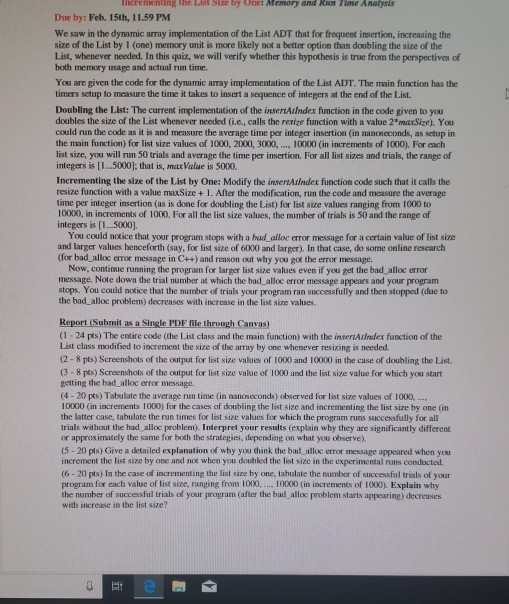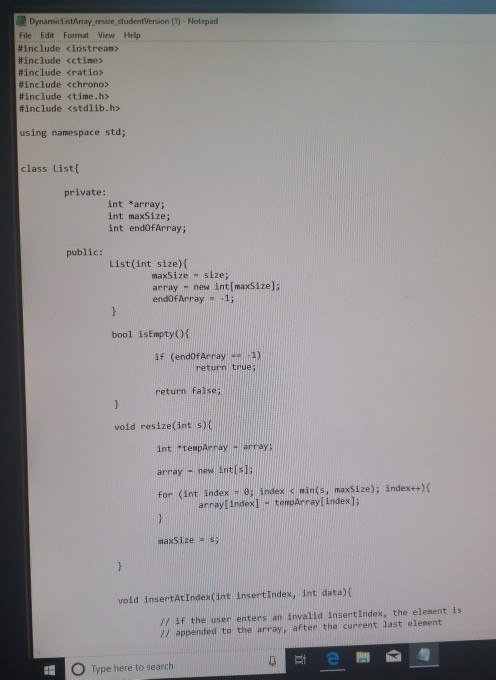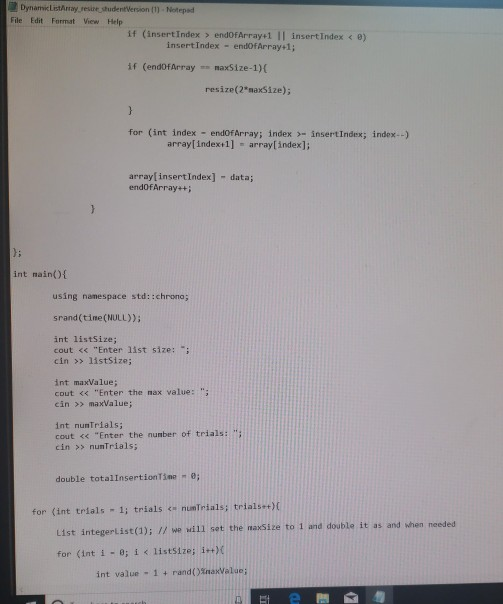Answered step by step
Verified Expert Solution
Question
1 Approved Answer
emory and Run nalysir Due by: Feb. 15th, 11.59 PM We saw in the dynamic array implementation of the List ADT that for frequent insertion,




emory and Run nalysir Due by: Feb. 15th, 11.59 PM We saw in the dynamic array implementation of the List ADT that for frequent insertion, increasing the size of the List by 1 (one) memory unit is more likely not a better option than doubling the size of the List, whenever needed. In this quiz, we will verify whether this hypothesis is true from the perspectives of both memory usage and actual run time. You are given the code for the dynamic amay implementation of the List ADT-The main function has the timers setup to measure the time it takes to insert a sequence of integers at the end of the List Doubling the List: The current implementation of the insertAuindex function in the code given to doubles the size of the List whenever needed (i.e., calls the resize function with a value 2"maxSize). You could run the code as it is and measure the average time per integer insertion (in nanoseconds, as setup in the main function) for list size values of 1000, 2000, 3000,., 10000 (in increments of 1000). For each list size, you will run 50 trials and average the time per insertion. For all list sizes and trials, the range of integers is [1...5000]; that is, maxValue is 5000. Incrementing the size of the List by One: Modify the insertAtindex function code such that it calls the resize function with a value maxSize + 1. After the modification, run the code and measure the avera time per integer insertion (as is done for doubling the List) for list size values ranging from 1000 to 10000, in increments of 1000. For all the list size values, the number of trials is 50 and the range of integers is [1. 5000]. You could nokice that your program stops with a bad alloc error message for a certain value of list si and larger values benceforth (say, for list size of 6000 and larger). In that case, do some online research (for bad alloc error message in C++) and reason out why you got the error message Now, continue running the program for larger list size values even if you get the bad alloc error message. Note down the trial number at which the bad alloc error message appears and your program stops. You could notice that the number of trials your program ran successfully and then stopped (due to the bad alloc problem) decreases with increase in the list size values. Report (Submit as a Single PDF file through Canvas) (1 24 pts) The entire code (the List class and the main function) with the insertAtindex function of the List class modified to increment the size of the array by one whenever resizing is needed (2-8 pts) Screenshots of the output for list size values of 1000 and 10000 in the case of doubling the List (3 -8 pts) Screenshols of the output for list size value of 1000 and the list size value for which you start getting the bad alloc error message (4 - 20 pts) Tabulate the average run time (in nancseconds) observed for list size values of 1000, 10000 (in increments 1000) for the cases of doubling the list size and incrementing the list size by one (in the latter case, tabulate the run times for list size values for which the program runs successfully for all trials without the bad alloc problem). Interpret your results (explain why they are significantly differert or approximately the same for both the strategies, depending on what you observe) (5 - 20 pls) Give a detailed explanation of why you think the bad alloc error message appeared when you increment the list size by one and not when you douhled the list size in the experimental runs conducted (6-20 pts) In the case of incrementing the list size by one, tahulate the Bumber of successful trials of your program for each valuc of list size, ranging from 1000.,... 10000 (in increments of 1000). Explain why he number of successful trials ol your program (after the bad alloc problem starts appearing) decreas with increase in the list size? DynamiclistAray resice st File Edit Format View Help include ciostrean> #include
Step by Step Solution
There are 3 Steps involved in it
Step: 1

Get Instant Access to Expert-Tailored Solutions
See step-by-step solutions with expert insights and AI powered tools for academic success
Step: 2

Step: 3

Ace Your Homework with AI
Get the answers you need in no time with our AI-driven, step-by-step assistance
Get Started


